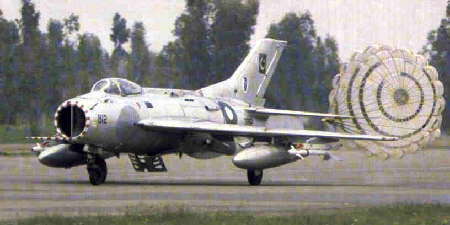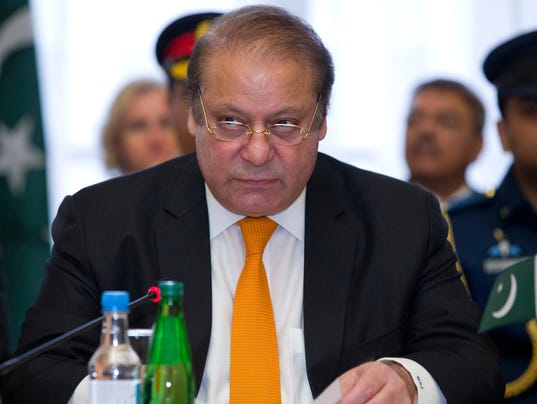انگریز
BANNED

- Joined
- Feb 20, 2015
- Messages
- 269
- Reaction score
- 2
- Country
- Location
ISLAMABAD — Pakistan's Air Force (PAF) Thursday stood up its unit of Chinese Karakorum Eagle AEW&C aircraft in a ceremony attended by the head of the PAF, Air Chief Marshal Tahir Rafiq Butt, and Prime Minister Nawaz Sharif.
Though the exact location of the ceremony was not given, it is believed to have been held at PAF Base Masroor in Karachi as the prime minister was known to have been in the city that day.
Brian Cloughley, an analyst and former Australian defense attache to Islamabad, said AEW&C "is very good news for the PAF – and for Pakistan" because it "will dramatically improve early warning capabilities which up until now have been comparatively rudimentary."
The ZDK-03 Karakorum Eagle is a dish-based AEW&C system mounted on a Shaanxi Y-8F600 aircraft. Though never confirmed, it has been speculated that the dish houses an AESA antenna.
Four were ordered in 2008 with the first delivered in 2010.
Air Commodore Syed Muhammad Ali, a spokesman for the Air Force, confirmed all Karakorum Eagle aircraft on order have now been delivered, but could not say if more would be ordered from China.
The aircraft join No.4 Squadron, which was first established in 1959 with Bristol Freighter transports and Grumman HU-16 Albatross amphibians. The amphibians were used for maritime reconnaissance, search and rescue, and casualty evacuation alongside Sikorsky H-19D helicopters. The HU-16s were retired in 1968 and the H-19Ds in 1969.
The unit was then "number-plated" until officially re-equipped with the Karakorum Eagle.
The four Karakorum Eagle AEW&C aircraft join the surviving three Saab Erieye AEW&C aircraft ordered in 2005 and delivered from 2009. One of the four Erieye aircraft was destroyed in a terrorist attack on Kamra Air Base in August 2012.
That the Air Force operates two types of AEW&C aircraft for the same mission has been much commented on.
Analyst Usman Shabbir of the Pakistan Military Consortium think tank says the Karakorum Eagle's mission is "asically the same job as Erieye but based in southern sector.
"To cover all the length of Pakistan we needed additional AEW&C aircraft and ZDK-03 was the answer due to political and financial considerations," he said.
Former Air Commodore Kaiser Tufail says the PAF was not keen on their purchase.
"The [Karakorum] Eagle was purchased rather reluctantly, under pressure of [then President] Gen. Musharraf, as a political expedient [Chinese appeasement], and not because of any reasons of technical superiority," he said. "It would have been more cost effective to manage a single type than these two vastly different ones."
Though he now believes attitudes have changed.
"Having said that, the performance of the Eagle has turned out to be surprisingly good, which takes some sting out of the initial criticism," he said.
Tufail says an absence of news of the fourth aircraft being delivered may mean it is undergoing installation of Link 16 datalink equipment to enable it to communicate with all of the PAF's aircraft, particularly its F-16s, and not just the JF-17 Thunders.
To date the Erieye AEW&C aircraft have been able to communicate with the Western aircraft in service such as the F-16, and the Karakorum Eagle with the Chinese aircraft such as the Sino-Pak JF-17, and perhaps the F-7PG.
Cloughley does not think this has changed.
"It's unlikely that the systems will complement those of the US, but cooperation with China is more important for Pakistan," he said.
PAF officials have previously told Defense News that this was impractical and would change.
Though perhaps not as technologically advanced as the Swedish Erieye, according to Haris Khan of the Pakistan Military Consortium think tank, the two types of AEW&C aircraft have worked very well together with the installation of Link 16 compatible equipment throughout the PAF's aircraft fleet.
Combined, they have effectively covered the country and much of Pakistan's maritime area of interest.
Email: uansari
Though the exact location of the ceremony was not given, it is believed to have been held at PAF Base Masroor in Karachi as the prime minister was known to have been in the city that day.
Brian Cloughley, an analyst and former Australian defense attache to Islamabad, said AEW&C "is very good news for the PAF – and for Pakistan" because it "will dramatically improve early warning capabilities which up until now have been comparatively rudimentary."
The ZDK-03 Karakorum Eagle is a dish-based AEW&C system mounted on a Shaanxi Y-8F600 aircraft. Though never confirmed, it has been speculated that the dish houses an AESA antenna.
Four were ordered in 2008 with the first delivered in 2010.
Air Commodore Syed Muhammad Ali, a spokesman for the Air Force, confirmed all Karakorum Eagle aircraft on order have now been delivered, but could not say if more would be ordered from China.
The aircraft join No.4 Squadron, which was first established in 1959 with Bristol Freighter transports and Grumman HU-16 Albatross amphibians. The amphibians were used for maritime reconnaissance, search and rescue, and casualty evacuation alongside Sikorsky H-19D helicopters. The HU-16s were retired in 1968 and the H-19Ds in 1969.
The unit was then "number-plated" until officially re-equipped with the Karakorum Eagle.
The four Karakorum Eagle AEW&C aircraft join the surviving three Saab Erieye AEW&C aircraft ordered in 2005 and delivered from 2009. One of the four Erieye aircraft was destroyed in a terrorist attack on Kamra Air Base in August 2012.
That the Air Force operates two types of AEW&C aircraft for the same mission has been much commented on.
Analyst Usman Shabbir of the Pakistan Military Consortium think tank says the Karakorum Eagle's mission is "asically the same job as Erieye but based in southern sector.
"To cover all the length of Pakistan we needed additional AEW&C aircraft and ZDK-03 was the answer due to political and financial considerations," he said.
Former Air Commodore Kaiser Tufail says the PAF was not keen on their purchase.
"The [Karakorum] Eagle was purchased rather reluctantly, under pressure of [then President] Gen. Musharraf, as a political expedient [Chinese appeasement], and not because of any reasons of technical superiority," he said. "It would have been more cost effective to manage a single type than these two vastly different ones."
Though he now believes attitudes have changed.
"Having said that, the performance of the Eagle has turned out to be surprisingly good, which takes some sting out of the initial criticism," he said.
Tufail says an absence of news of the fourth aircraft being delivered may mean it is undergoing installation of Link 16 datalink equipment to enable it to communicate with all of the PAF's aircraft, particularly its F-16s, and not just the JF-17 Thunders.
To date the Erieye AEW&C aircraft have been able to communicate with the Western aircraft in service such as the F-16, and the Karakorum Eagle with the Chinese aircraft such as the Sino-Pak JF-17, and perhaps the F-7PG.
Cloughley does not think this has changed.
"It's unlikely that the systems will complement those of the US, but cooperation with China is more important for Pakistan," he said.
PAF officials have previously told Defense News that this was impractical and would change.
Though perhaps not as technologically advanced as the Swedish Erieye, according to Haris Khan of the Pakistan Military Consortium think tank, the two types of AEW&C aircraft have worked very well together with the installation of Link 16 compatible equipment throughout the PAF's aircraft fleet.
Combined, they have effectively covered the country and much of Pakistan's maritime area of interest.
Email: uansari











